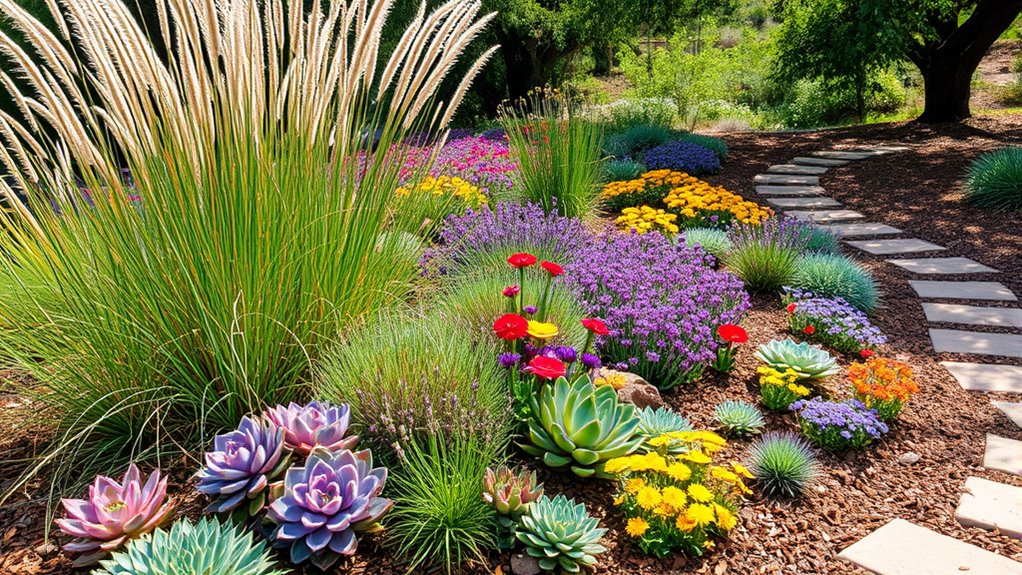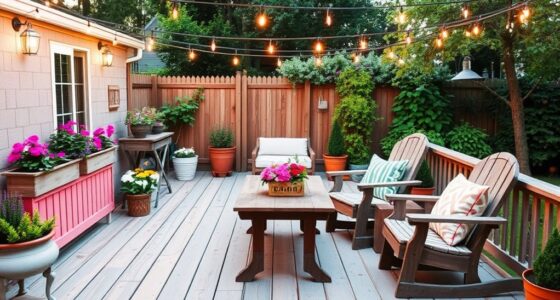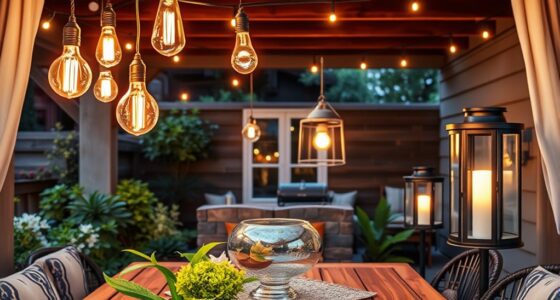Creating a low-maintenance native plant garden allows you to support local wildlife while reducing effort. Choose plants suited to your climate and soil, arrange them naturally, and enrich the soil with compost. Group plants in easy-to-maintain clusters, add mulch to conserve moisture, and water only as needed. Avoid chemicals and plant a diverse mix to attract pollinators. Keep exploring for expert tips on designing a thriving, resilient native landscape that requires minimal upkeep.
Key Takeaways
- Select region-specific native plants adapted to local climate and soil conditions.
- Arrange plants in natural groupings to mimic ecosystems and reduce maintenance.
- Incorporate mulch and organic matter to conserve moisture and suppress weeds.
- Use minimal hardscaping and permeable pathways to support water flow and soil health.
- Focus on soil enrichment and proper spacing to promote healthy growth and reduce plant competition.
Selecting the Right Native Plants for Your Space
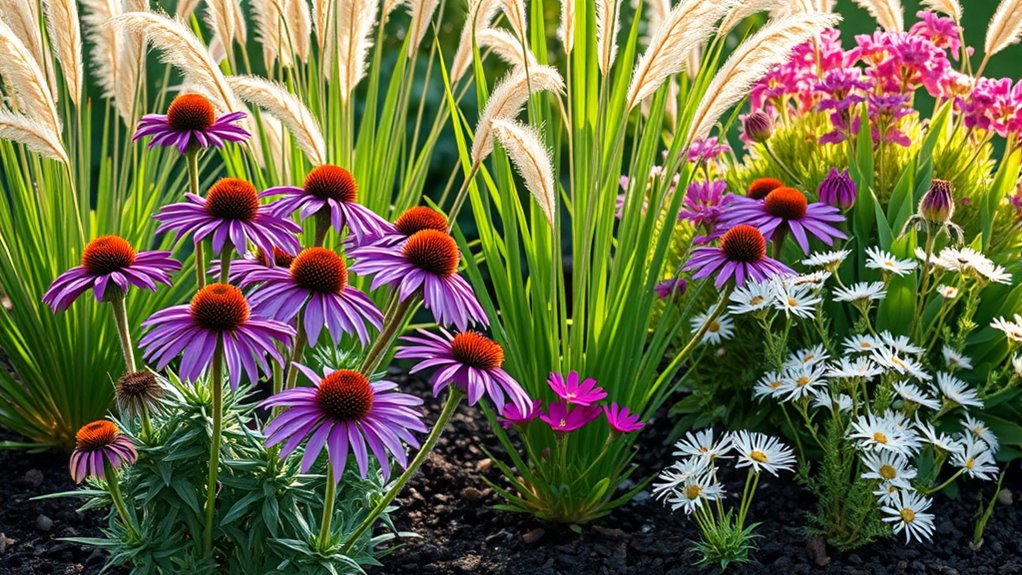
Choosing the right native plants for your space starts with understanding your site’s specific conditions, such as soil type, sunlight exposure, and moisture levels. Conduct soil testing to determine pH and nutrient content, helping you select plants suited to your soil. Once you have this data, consult native plant catalogs, which provide detailed information on species adapted to your region. These catalogs often include recommendations based on soil conditions, sunlight requirements, and water needs. By matching your site’s characteristics with plant specifications, you’ll ensure healthier growth and a low-maintenance garden. Additionally, researching Water Parks in your area can provide inspiration for creating a lush, inviting landscape that encourages relaxation and enjoyment. Taking the time to assess your environment and explore catalogs saves you effort in the long run, creating a thriving native plant garden that naturally fits your landscape.
Designing a Low-Impact Garden Layout
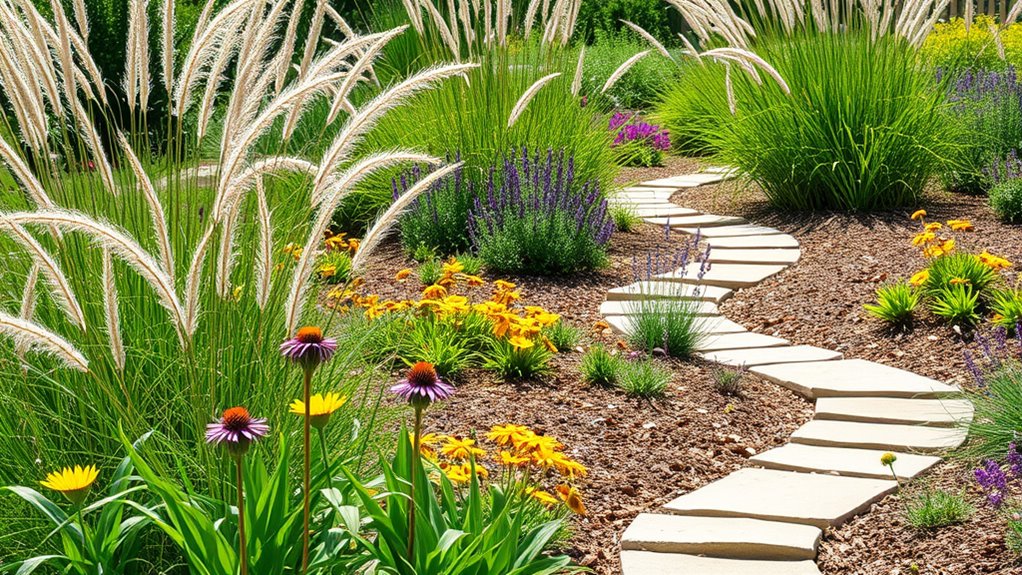
Once you’ve selected the right native plants for your space, the next step is to design a garden layout that minimizes environmental impact. Start by arranging plants in natural groupings that mimic their native ecosystems, reducing maintenance needs. Incorporate decorative pathways made from permeable materials like gravel or stepping stones to prevent runoff and improve drainage. Keep garden furniture minimal and eco-friendly, choosing pieces that blend with the landscape without overpowering it. Position pathways to guide visitors smoothly through the space, highlighting key plant areas and creating a sense of flow. Avoid unnecessary hardscaping that could disrupt local water flow or soil health. Planning your garden layout with native plant placement can also help attract local pollinators and support biodiversity. A thoughtfully planned layout not only conserves resources but also enhances the natural beauty of your native garden.
Preparing Soil and Planting Techniques
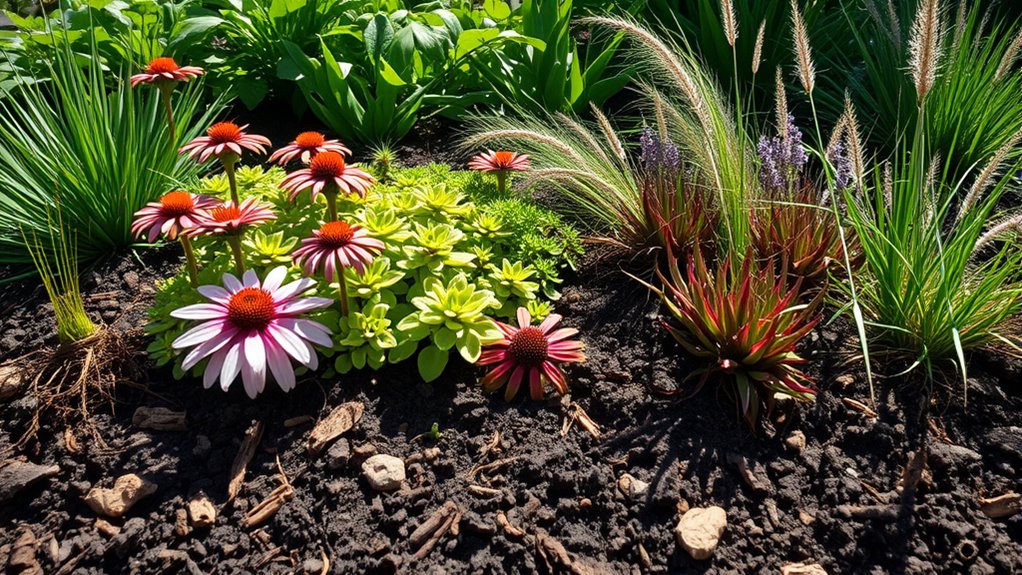
Before planting your native garden, preparing the soil properly guarantees healthy growth and long-term sustainability. Start by testing your soil’s pH and nutrient levels to identify any deficiencies. Amend the soil with organic matter, such as compost, to improve drainage and fertility. When it comes to planting techniques, loosen the soil to a depth of about 12 inches to allow roots to establish easily. Dig individual holes slightly larger than each plant’s root ball, and avoid over-fertilizing, as native plants thrive in minimal intervention. Place plants at the correct depth, firming the soil around them to eliminate air pockets. Proper soil preparation combined with effective planting techniques ensures your native plants will establish quickly and require less maintenance over time. Additionally, understanding the contrast ratio of your soil and plants can help optimize light absorption and overall health.
Watering and Maintenance Tips for Native Gardens
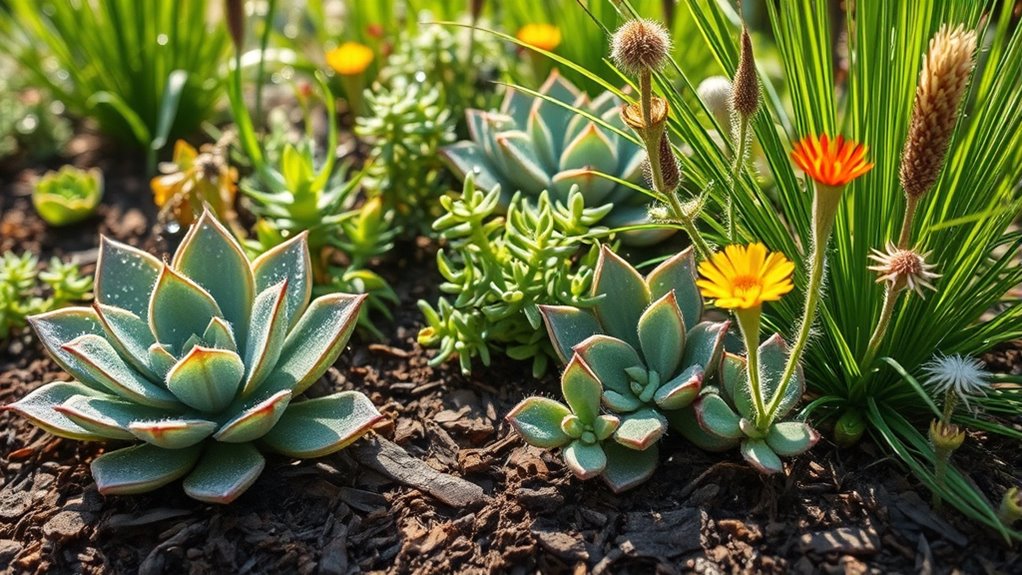
To keep your native garden thriving, regular watering and ongoing maintenance are essential. Pay attention to watering frequency, which depends on your local climate and recent rainfall. Typically, new plants need more consistent watering until established, usually once a week. Once established, native plants often require less watering, especially during cooler months. Make seasonal adjustments by reducing watering in fall and winter, when plants are dormant, and increasing it during hot, dry summers. Check soil moisture regularly to prevent overwatering or drought stress. Mulching helps retain soil moisture and reduces watering needs. Keep an eye on weather patterns and modify your watering schedule accordingly. Proper maintenance ensures your native garden remains healthy, vibrant, and low-maintenance over time. Additionally, understanding how wood-burning impacts the environment can help gardeners make more sustainable choices for their outdoor spaces.
Managing Pests and Diseases Naturally

Managing pests and diseases naturally is an effective way to keep your native garden healthy without relying on chemical treatments. You can achieve this through techniques like companion planting and using natural pest deterrents. Companion planting involves pairing plants that repel pests with vulnerable species, reducing infestations naturally. Natural pest deterrents such as neem oil or insecticidal soaps can also protect your plants without harmful chemicals. To visualize these strategies, consider this table:
| Plant Pairing | Pest Deterrent | Benefits |
|---|---|---|
| Marigolds with tomatoes | Companion planting | Repels nematodes and aphids |
| Lavender with roses | Natural pest deterrents | Fends off mosquitoes, beetles |
| Basil with peppers | Companion planting | Discourages aphids, flies |
| Peppermint with cabbage | Natural pest deterrents | Repels cabbage moths |
Using these methods keeps your native garden thriving and low-maintenance. Incorporating biological controls like beneficial insects can further enhance natural pest management and promote a balanced ecosystem.
Enhancing Biodiversity and Supporting Local Wildlife
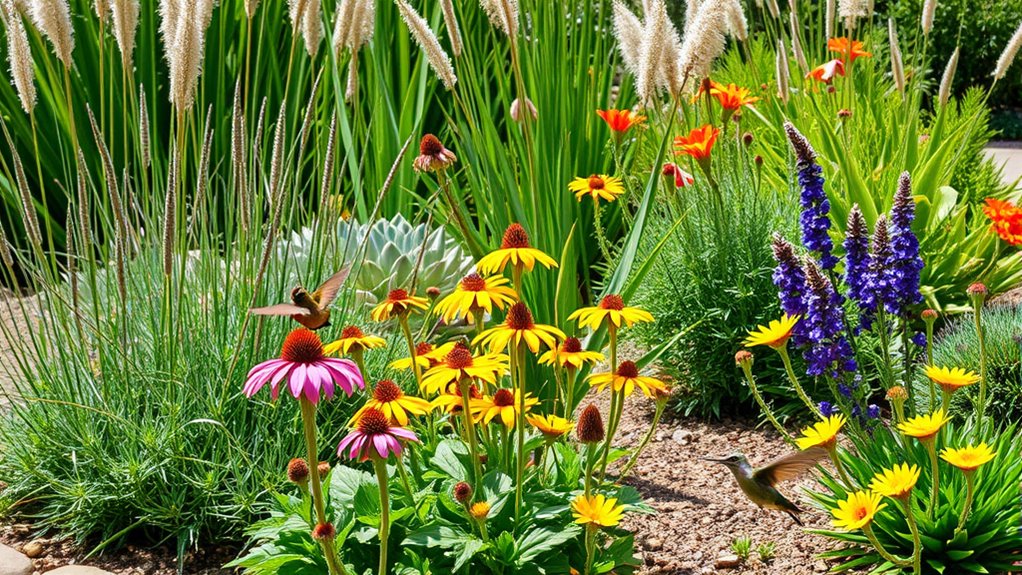
By planting native species, you attract pollinators like bees and butterflies, which are essential for healthy ecosystems. Your garden can also support local bird populations by providing food and shelter. Together, these efforts help create a balanced environment that benefits all wildlife and promotes ecosystem stability. Incorporating native plant varieties can also reduce the need for maintenance and chemical treatments, making your garden more sustainable.
Native Plants Attract Pollinators
Have you ever wondered how planting native species can boost your garden’s health? Native plants attract pollinators like bees, butterflies, and hummingbirds, creating essential pollinator partnerships. These partnerships improve plant reproduction and increase garden productivity. Native plant benefits go beyond aesthetics; they provide necessary nectar and pollen sources at different times of the year, supporting pollinators’ lifecycles. By choosing native plants, you create a thriving ecosystem that naturally draws pollinators, reducing the need for chemical interventions. This not only enhances your garden’s biodiversity but also promotes a balanced environment that benefits all wildlife. With less maintenance required, native plants make your garden more resilient and vibrant, while supporting local pollinator populations that are fundamental for ecological health. Native plant adaptability ensures these species thrive with minimal intervention, making your garden both sustainable and beautiful.
Support Local Bird Species
Supporting local bird species begins with planting native trees, shrubs, and flowering plants that provide essential food and shelter. These plants attract diverse bird populations, enriching your garden’s ecosystem. To maximize benefits, consider:
- Including dense shrubs for nesting sites
- Incorporating flowering plants for seasonal color and nectar
- Adding bird-friendly garden art, like feeders or nesting boxes
- Selecting plants that produce berries or seeds for year-round food
- Engaging in dynamic communication exercises to better understand and connect with your local wildlife and fellow gardeners.
Create Ecosystem Stability
Planting native species not only attracts birds but also helps build a resilient garden ecosystem. To create stability, focus on soil enrichment through organic matter and maintain proper plant spacing. Well-spaced plants reduce competition for nutrients and water, supporting diverse species. This diversity fosters a balanced environment where native insects, pollinators, and wildlife thrive. Consider this table for ideal plant selection:
| Native Plants | Soil Enrichment Tips | Spacing Recommendations |
|---|---|---|
| Wildflowers | Add compost annually | 12-18 inches apart |
| Shrubs | Mulch to retain moisture | 3-4 feet apart |
| Grasses | Use organic fertilizers | 2-3 feet apart |
Additionally, selecting plants adapted to your local climate ensures long-term sustainability and reduces maintenance needs.
Frequently Asked Questions
How Do I Choose Native Plants Suitable for Shady Areas?
When choosing native plants for shady areas, focus on their shade tolerance to guarantee they thrive. Check the soil preferences, such as moisture and acidity levels, to match your garden’s conditions. Look for plants adapted to low-light environments, like ferns or certain woodland wildflowers. By selecting plants with appropriate shade tolerance and soil needs, you’ll create a lush, low-maintenance space that flourishes with minimal effort.
What Are the Best Native Plants for Drought-Prone Soils?
Drought-prone soils are like a cracked, thirsty desert needing resilient native plants. You’ll want to focus on native plant propagation, choosing species like coneflowers, sedums, and yucca, which thrive in dry conditions. Proper soil preparation techniques, such as amending with organic matter and ensuring good drainage, help these plants flourish. By selecting hardy natives and preparing the soil well, you create a landscape that’s both sustainable and vibrant despite the drought.
How Can I Prevent Invasive Species From Encroaching?
To prevent invasive species from encroaching, you should use effective mulching techniques to suppress unwanted weeds and invasive plants. Regularly monitor your garden and remove any invasive seedlings early. Additionally, focus on native plant propagation by planting well-established native species, which naturally compete with invasives. Maintaining a healthy, diverse native plant community creates a natural barrier, reducing the chances for invasives to take hold and thrive in your garden.
Are Native Plants Compatible With Garden Irrigation Systems?
When wondering if native plants work with your watering wonder, worry not. Native plant maintenance pairs perfectly with your irrigation system, simplifying sprinkler schedules and streamlining sustainability. You’ll find that native plants flourish freely when properly paired with compatible irrigation, creating a cozy, caring climate for your garden. So, yes, native plants and your irrigation system can coexist comfortably, cultivating a charming, chlorophyll-rich corner that’s both convenient and mesmerizing.
What Are Eco-Friendly Ways to Control Weeds Naturally?
To control weeds naturally, you can use eco-friendly methods like compost mulching and hand weeding. Compost mulching suppresses weeds by blocking sunlight and enriching your soil, making it harder for unwanted plants to grow. Hand weeding is effective and avoids chemicals, allowing you to remove weeds carefully without disturbing your native plants. Regularly applying these techniques keeps your garden healthy and weed-free while respecting the environment.
Conclusion
Creating a native plant garden is like tending a thriving ecosystem—your personal sanctuary that blooms with minimal effort. By choosing the right plants, designing thoughtfully, and caring naturally, you’ll turn your space into a vibrant haven that supports local wildlife and reduces maintenance. Embrace this journey as nurturing a living treasure chest—each plant a gem that, with patience and care, will reward you with beauty and sustainability for years to come.
